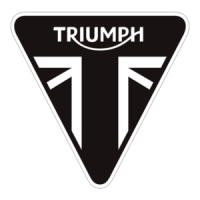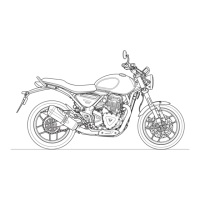51
How to Ride the Motorcycle
ABS (Anti-Lock Brake System)
models only
ABS Warning Light
The ABS indicator light
illuminates to show that the ABS
function is not available.
Illumination is normal after engine start-up,
and until the motorcycle first reaches a speed
exceeding 6 mph (10 km/h). Unless there is a
fault, it should not illuminate again until the
engine is restarted.
If the indicator light becomes illuminated at
any other time while riding, it indicates that
the ABS has a malfunction that requires
investigation.
Note:
• Normally, the rider will perceive
ABS operation as a harder feel or a
pulsation of the brake lever and
pedal. As the ABS is not an
integrated braking system and it
does not control both the front
and rear brake at the same time,
this pulsation may be felt in the
lever, the pedal or both.
• The ABS may be activated by
sudden upward or downward
changes in the road surface.
Warning
Where fitted, ABS prevents the wheels
from locking, therefore maximising the
effectiveness of the braking system in
emergencies and when riding on slippery
surfaces. The potentially shorter braking
distances ABS allows under certain
conditions are not a substitute for good
riding practice.
Always ride within the legal speed limit.
Never ride without due care and attention
and always reduce speed in consideration
of weather, road and traffic conditions.
Take care when cornering. If the brakes are
applied in a corner, ABS will not be able to
counteract the weight and momentum of
the motorcycle. This can result in loss of
control and an accident.
Under some circumstances it is possible
that a motorcycle equipped with ABS may
require a longer stopping distance than an
equivalent motorcycle without ABS.
Warning
If the ABS is not functioning, the brake
system will continue to function as a
non-ABS braking system. Do not continue
to ride for longer than is necessary with the
indicator light illuminated. Contact an
authorised Triumph dealer as soon as
possible to have the fault checked and
rectified. In this situation, braking too hard
will cause the wheels to lock resulting in
loss of control and an accident.
